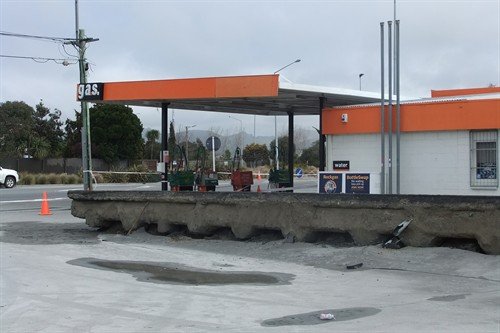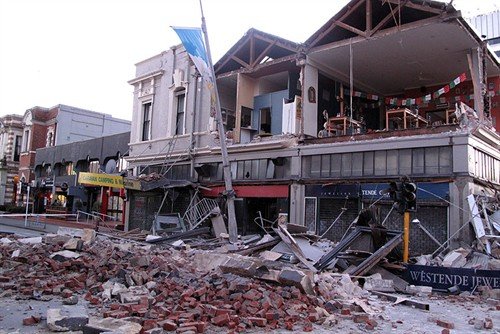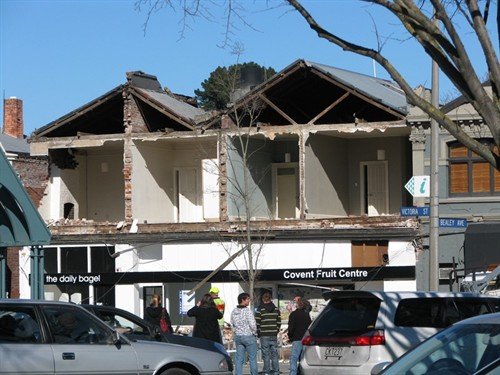Life turned upside down
Our new collection of photographs from UC’s Department of Civil and Natural Resources Engineering showcases the experiences of some of its staff and students during the 2010 and 2011 Canterbury earthquakes. The photographs were taken by staff and postgraduate students working in the department at the time, including Department Administrator Elizabeth Ackermann and Research Engineer Umut Akguzel.
Recently, Elizabeth took the time to sit down with CEISMIC and tell us some of her earthquake stories.
4 September 2010
It is a cliché now, but after being shaken awake at 4.35 am on that cold, dark Christchurch morning on 4 September 2010 life was literally turned upside down for our family as it was for other Cantabrians. That morning I was alone in my cottage in New Brighton. My daughter, Danica, was living in Poplar Lane in a 3rd floor apartment with her flatmates in a masonry heritage apartment and my son, Tristan, was staying with a friend. The incredible noise and the violent shaking of the house brought an adrenaline rush you don’t often experience. My instinct was flight so I ran outside. Car and house alarms were going off but apart from that it was eerily quiet, very dark and very cold. My neighbour across the road standing on his porch asked if I was alright and said, “That was a big one.” A mild understatement as we now know. I just wanted to get to town to find Danica as her apartment block was an old masonry building and would be vulnerable. Car lights were already appearing from side streets as people were exiting New Brighton in a quiet and orderly fashion over the Pages Road Bridge. The fear of a possible tsunami was foremost in the minds of everyone who lived close to the ocean. I followed not realizing we were driving through muddy waters caused by liquefaction (didn’t even know the word then) and water from burst water mains on Pages Road. On the way I noticing collapsed walls, chimneys, and what really stands out in my memory that night is the Asian family who lived above their dairy on Woodham Road standing outside with blankets around them looking shocked as a whole wall from their upstairs apartment had collapsed on the street.
The forecourt of a petrol station near New Brighton which has risen out of the ground.
Arriving in the central Christchurch I also quickly realized the damage there was far more serious and noticeable than in the suburbs. Facades on Manchester Street and old buildings on the way had fallen with brick walls collapsing onto parked cars. I was frantic to find Danica and after a while found her and her friends wrapped in blankets, walking in High street.
Earthquake-damaged buildings on Manchester Street.
It was a huge relief for both of us. Tristan txted me that he was safe as well so after a while I went back to New Brighton and got into bed. There was really nothing else to do as it was so cold and we had no power. Later that day friends and workmates came to check on me. We were all in shock by what happened.
In the days following this it was very therapeutic to walk around with a camera and document what happened to my suburb and to Christchurch. I used to work as a journalist so always have this natural instinct of documenting. The day after the earthquake was very sunny and beautiful. I remember going to New Brighton beach as we could not go into work since the University was closed. Sitting on the deserted New Brighton beach on a beautiful sunny day as if nothing out of the ordinary has happened to us was a strange feeling. You just know that everything has suddenly changed forever.
Danica and I took walks through the city. It was a beautiful spring and blossoms were just starting to appear. People were walking around everywhere in the city taking photos of the damage, looking stunned and everyone was saying how lucky we were that no one died. We continued life as best we could, with some major aftershocks on the Wednesday from the Lyttelton area. I had a bad feeling that this was going to get worse as the aftershocks were very bad and constant.
Earthquake-damaged buildings on Victoria Street.
It was also impossible to get away from the reality of the earthquake (apart from being here for every aftershock) as I work at the Department of Civil and Natural Resources Engineering at UC and our structures and geotech staff and students were intensely involved in data gathering and inspections since the quake on 4 September. The workload was always high but afterwards it spiralled out of control for a lot of staff and students, and also for the admin support staff such as myself. We all pitched in with cleaning up our offices when we were allowed back. Coming back to the offices on level 4 of the Civil/Mechanical building was quite a shock as basically everything was tossed and thrown around and there wasn’t one office where books didn’t litter the floor, filing cabinets weren’t flung open and tipped over with the contents everywhere. Broken glass had to be cleaned up. We tried to bring some normality as quick as possible, while the structural staff were part of the building assessment and USAR teams that went into the CBD to access buildings.
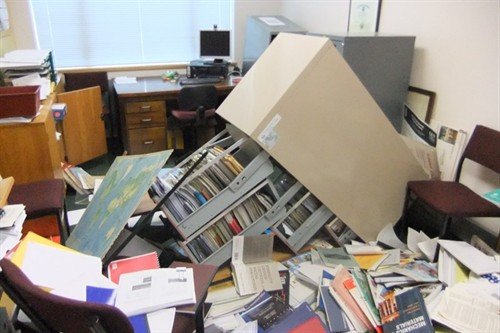
A toppled filing cabinet in an office in the Department of Civil and Natural Resources Engineering.
The irony was that most of our structures academic staff and postgraduate students were in Macedonia at the 1st European Earthquake Conference the moment the quake struck Christchurch. Most returned immediately to Christchurch to start work and be part of the assessment process in the city. Our postgraduate students gave up valuable time of their own research to help with this and of course some exciting new research opportunities and PhD research titles emerged from the disaster. Once allowed back to work we immediately started planning effective emergency earthquake procedures as did the UC emergency teams. Health and Safety suddenly became very important.
22 February 2011
Life went literally rocking on until 22 February. It was a beautiful summer’s day and my daughter’s birthday was coming up on 23 February. That weekend we had a barbeque with friends. It was the second day of the new academic year and students were back on campus. At 12.51 pm on 22 February I was at work in my office on level 4 in the Civil Engineering building when the 6.3 quake struck. I looked at Catherine who sat across the hall from me and just sat there frozen holding my monitor to prevent it from flying across the office. At no point did I think to dive under my desk or stand in the doorframe. Books fell in front of my office door and as alarms went off and people started to run out, I had to force the door open. I remember two of our visiting Italian research students who were leaving the next day back to Italy running up the steps to their office to grab their stuff and passports and being told they couldn’t go upstairs. That was one of the big problems we all had afterwards as we left handbags, passports, car keys, mobile phones etc in the offices not realizing we won’t be allowed back in for some weeks! We were allowed back into our building on Monday 28 March, 5 weeks after the quake. After this we always carried our handbags with keys and laptop bags with us (even to the toilet) and you never left your office without checking if you had your keys and mobile phone at least. You also checked your phone battery a hundred times a day.
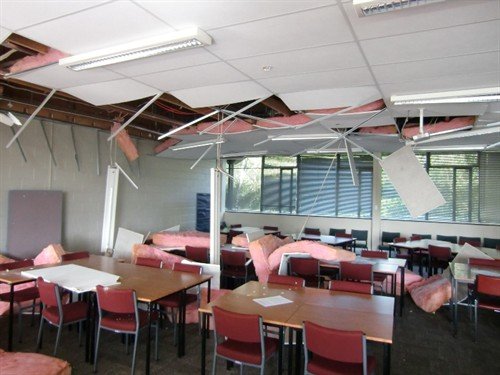
Fallen ceiling tiles and pink batts in a teaching room at the University of Canterbury.
However we tried to keep work going by working from home (very difficult through remote access to campus network drives and with limited resources). Our HOD at the time, Roger Nokes, was an amazing leader and in no time organized for our whole department, including undergrads, to move to the Avonhead Baptist Church (we called it the ABC campus). They kindly leased their premises to us for our undergraduate student teaching. Catherine, our undergrad administrator, actually rang a bell between classes like in the olden days. We were working in their Sunday-school rooms and the technicians from our labs looked after us, setting up and supporting the whole move. It was special time, and I still feel our department bonded then more than at any other time.
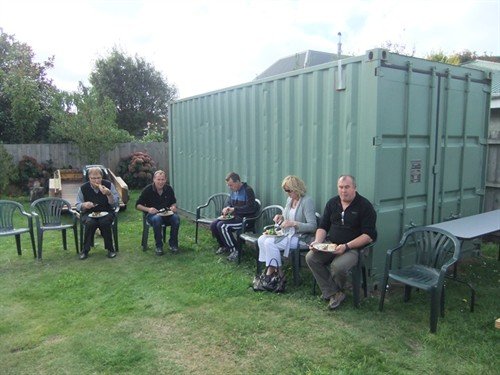
Administrators and technicians from the Department of Civil and Natural Resources Engineering enjoy a barbeque outside the Avonhead Baptist Church.
On the home front my house in New Brighton survived quite well and I was lucky to have no liquefaction damage, but it now has a definite tilt to the west (towards the river) and I, like many others, am still waiting for EQC to make a final decision after numerous assessments. These were traumatic times to say the least for all of us in Christchurch and what we all went through is still difficult to put into words. The aftershocks were the worst as you never knew when to expect one and your heart would race like hell. One night I slept in the car as I felt safer there. We thought the aftershocks would never end. We were told by counsellors at Uni that strange behaviour was perfectly "normal" after a natural disaster.
Life after the quakes
I drive past Hagley Park in the morning on the way to work and look at the daffodils and the beautiful park, and think how lucky we are to live here in Christchurch. It is so easy to live here regardless of the road works and million road cones. Everything is so convenient and so beautiful still. We have so much artistic creativity and beauty around us.
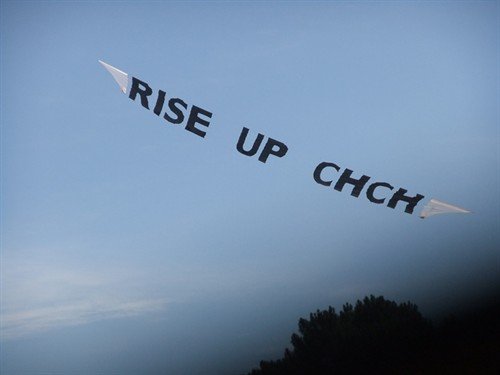
A banner reading, "Rise Up Christchurch," flies above the Christchurch Earthquake Memorial Service in Hagley Park.
Now there are new staff and students who didn’t share our quake experience and at times it is difficult for them to relate to us who went through this and vice versa. But most of all I learned that I am strong and can endure more than I thought. We are also very lucky to have the community and friends around us that we have. Four years on I have hope for my city, no matter how slow the recovery. I am excited about new buildings, cafés, places to go, and to see old ones come back to life. It’s like a Christmas in Christchurch for me as there is always something new to discover amongst the demolition and loss. We are able to live in a brand new developing city but actually the same city in the same lifetime. Not many people get to do that. I am also not the same person I was before the quake, but I don’t think anyone is. I feel more in touch with my community and the need to make a difference and contribute. I feel blessed to live here and have my children, my community, my wonderful friends, my little house and my job in this inspiring city. If I were to leave I would feel somehow that I am betraying Christchurch, so for now the plan is to stay.
CEISMIC would like to thank Elizabeth Ackermann and the other staff and postgraduate students from the Department of Civil and Natural Resources Engineering for their generous contribution to the archive. We look forward to archiving more stories and material from their department, as well as other schools and departments across the University of Canterbury.

Photographs of petrol station, filing cabinets, UC Engineering staff, and 'Rise Up Christchurch' banner by Elizabeth Ackermann, licensed under a Creative Commons Attribution-NonCommercial-NoDerivatives License.

Photographs of Manchester Street and UC teaching room by Umut Akguzel, licensed under a Creative Commons Attribution-NonCommercial-NoDerivatives License.

Photograph of Victoria Street by UC Civil and Natural Resources Engineering Department staff, licensed under a Creative Commons Attribution-NonCommercial-NoDerivatives License.

